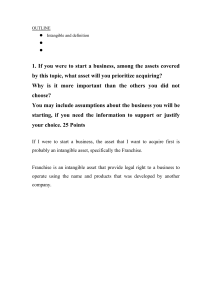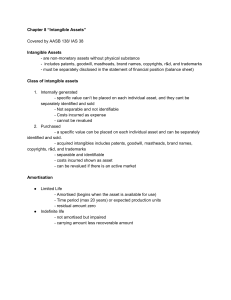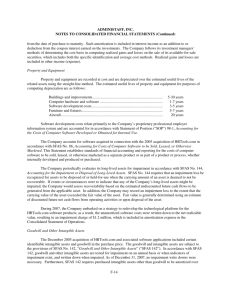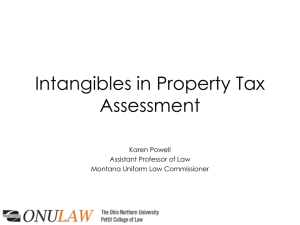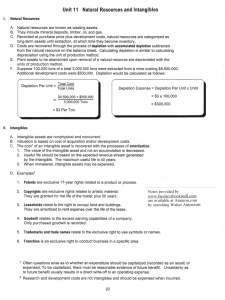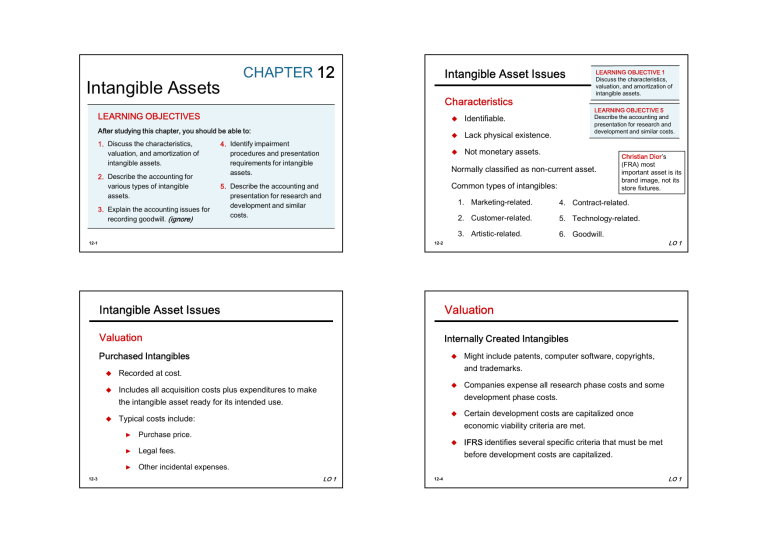
Intangible Assets CHAPTER 12 Intangible Asset Issues Characteristics LEARNING OBJECTIVES After studying this chapter, you should be able to: 1. Discuss the characteristics, valuation, and amortization of intangible assets. 2. Describe the accounting for various types of intangible assets. 3. Explain the accounting issues for recording goodwill. (ignore) 4. Identify impairment procedures and presentation requirements for intangible assets. Identifiable. Lack physical existence. Not monetary assets. LEARNING OBJECTIVE 5 Describe the accounting and presentation for research and development and similar costs. Normally classified as non-current asset. Common types of intangibles: 5. Describe the accounting and presentation for research and development and similar costs. 12-1 Christian Dior’s (FRA) most important asset is its brand image, not its store fixtures. 1. Marketing-related. 4. Contract-related. 2. Customer-related. 5. Technology-related. 3. Artistic-related. 6. Goodwill. 12-2 Intangible Asset Issues Valuation Valuation Internally Created Intangibles Purchased Intangibles 12-3 LEARNING OBJECTIVE 1 Discuss the characteristics, valuation, and amortization of intangible assets. Might include patents, computer software, copyrights, and trademarks. Recorded at cost. Includes all acquisition costs plus expenditures to make the intangible asset ready for its intended use. Companies expense all research phase costs and some development phase costs. Typical costs include: Certain development costs are capitalized once economic viability criteria are met. IFRS identifies several specific criteria that must be met before development costs are capitalized. ► Purchase price. ► Legal fees. ► Other incidental expenses. LO 1 LO 1 12-4 LO 1 Intangible Asset Issues Research and Development Costs Internally Created Intangibles Research and development (R&D) costs are not in themselves intangible assets. Frequently results in the development of patents or copyrights such as new ILLUSTRATION 12.1 Research and Development Stages LO 1 12-5 Research costs must be expensed as incurred. Development costs may or may not be expensed as incurred. 12-7 product, formula, process, composition, or idea, literary work. LO 5 12-6 Research and Development Costs Research and Development Costs Identifying R & D Activities Capitalization begins when the project is far enough along in the process such that the economic benefits of the R&D project will flow to the company (the project is economically viable). LO 5 ILLUSTRATION 12.14 Research Activities versus Development Activities Research Activities Examples Original and planned investigation undertaken with the prospect of gaining new scientific or technical knowledge and understanding. Laboratory research aimed at discovery of new knowledge; searching for applications of new research findings. Development Activities Application of research findings or other knowledge to a plan or design for the production of new or substantially improved materials, devices, products, processes, systems, or services before the start of commercial production or use. 12-8 Examples Conceptual formulation and design of possible product or process alternatives; construction of prototypes and operation of pilot plants. LO 5 Intangible Asset Issues Intangible Asset Issues Amortization of Intangibles Amortization of Intangibles Limited-Life Intangibles Indefinite-Life Intangibles No foreseeable limit on time the asset is expected to provide cash flows. the company consumes or uses up the asset. No amortization. Credit asset account or accumulated amortization. Amortization base should be cost less residual value. Must test indefinite-life intangibles for impairment at least annually. Companies must evaluate the limited-life intangibles Amortize by systematic charge to expense over useful life. Amortization expense should reflect the pattern in which annually for impairment. LO 1 12-9 LO 1 12-10 Intangible Asset Issues LEARNING OBJECTIVE 2 Describe the accounting for various types of intangible assets. Types of Intangible Assets Amortization of Intangibles Six Major Categories: 1. Marketing-related. 4. Contract-related. 2. Customer-related. 5. Technology-related. 3. Artistic-related. 6. Goodwill. ILLUSTRATION 12.2 Accounting Treatment for Intangibles 12-11 LO 1 12-12 LO 2 Marketing-Related Intangible Assets Customer-Related Intangible Assets Examples: ► Trademarks or trade names, newspaper mastheads, Internet domain names, etc. Examples: ► Customer lists, order or production backlogs, and both contractual and non-contractual customer relationships. Under common law, the right to use a trademark or trade name rests exclusively with the original user as long as the original user continues to use it. Capitalize acquisition costs. Capitalize purchase price. Amortized to expense over useful life. No amortization. Top 3 Most Expensive Domain Names In The World 2018 Source: Finances Online (https://financesonline.com/top-10-most-expensive-domain-names-in-the-world-insurance-rentals-private-jets/) 1. LasVegas.com – $90 million (2005-2040) 2. CarInsurance.com– $49.7 million (2010) 3. Insurance.com – $35.6 million (2010) 12-13 LO 2 Artistic-Related Intangible Assets 12-15 Contract-Related Intangible Assets Examples: ► LO 2 12-14 Plays, literary works, musical works, pictures, photographs, and video and audiovisual material. Examples: ► Copyright granted for the life of the creator plus 70 years. Capitalize costs of acquiring and defending. Amortized to expense over useful life if less than the legal life. LO 2 12-16 Franchise and licensing agreements, construction permits, broadcast rights, and service or supply contracts. Franchise (or license) with a limited life should be amortized as operating expense over the life of the franchise. Franchise with an indefinite life should be carried at cost and not amortized. LO 2 Technology-Related Intangible Assets Goodwill Examples: ► Conceptually, represents the future economic benefits arising from the other assets acquired in a business combination that are not individually identified and separately recognized. Patented technology and trade secrets granted by a government body. Patent gives holder exclusive use for a period of 20 years. Capitalize costs of purchasing a patent. Expense all R&D costs and any development costs incurred before achieving economic viability. Amortize over legal life or useful life, whichever is shorter. Only recorded when an entire business is purchased. Goodwill is measured as the ... excess of cost over the fair value of the identifiable net assets (assets less liabilities) acquired. Internally created goodwill should not be capitalized. LO 2 12-17 Impairment of Intangible Assets LO 3 12-18 LEARNING OBJECTIVE 4 Identify impairment procedures and presentation requirements for intangible assets. Impairment of Limited-Life Intangibles The rules that apply to impairments of property, plant, and equipment also apply to limited-life intangibles*. An intangible asset is impaired when a company is not able to recover the asset’s carrying amount either through using it or by selling it. The impairment loss is the carrying amount of the asset less the recoverable amount of the impaired asset. • For limited-life intangibles, a review of impairment indicator is required, and an impairment test will be carried out only if impairment indicator present. (Same rule applies to impairment of PPE) • For indefinite-life intangibles, impairment test will be carried out even impairment indicators are not present. (HKAS 38, para IN12) 12-19 LO 4 12-20 Reading and Assignment Impairment of Limited-Life Intangibles Fair value less costs to sell means what the asset could be sold for after deducting costs of disposal. Value-in-use is the present value of cash flows expected from the future use and eventual sale of the asset at the end of its useful life. 12-21 LO 4 12-22 Read Chapter 12, Intermediate Accounting, IFRS 3rd Edition, Kieso / Weygandt / Warfield, Wiley Hong Kong Accounting Standard 38, Intangible Assets (for reference) Hong Kong Accounting Standard 36, Impairment of Assets (for reference) Attempt the following exercises in Chapter 12 Brief Exercises: BE12.1 to BE12.4, BE12.6, BE12.7, BE12.10 to BE12.12, BE12.14
